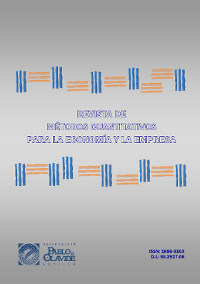Similitud entre el cuadrado del coeficiente de variación y el índice de Gini en una variable aleatoria general
DOI:
https://doi.org/10.46661/revmetodoscuanteconempresa.2158Palabras clave:
Concentration measures, cumulative distribution function, Lorenz curve, mean difference, medidas de concentración, función de distribución, curva de Lorenz, diferencia mediaResumen
En este trabajo se obtienen diversas identidades relativas a la espezanza, varianza, covarianza, función de distribución acumulada, coeficiente de variación y curva de Lorenz que se usarán para obtener resultados teóricos interesantes. Se construye, además, una representación gráfica de la varianza, la cual, utilizando las propiedades obtenidas, nos indica que el cuadrado del coeficiente de variación se puede considerar como una medida de igualdad, de igual forma que se considera al índice de Gini. En este artículo también se lleva a cabo un estudio de las similitudes entre la expresión teórica del índice de Gini y el cuadrado del coeficiente de variación.
Descargas
Citas
Bartels, C.P.A. (1977): Economic aspects of regional welfare. Martinus Nijhoff Sciences Division.
Dalton, H. (1920): Measurement of the inequality of income. Economic Journal 30, 348–361.
Davies, J. and Hoy, M. (1994): The normative significance of using third-degree stochastic dominance in comparing income distributions. Journal of Economic Theory 64, 520–530.
Dorfman, R. (1979): A formula for the Gini coefficient. Review of Economics and Statistics (61), 146–149.
Fishburn, P. (1980): Stochastic dominance and moments of distributions. Mathematics of Operations Research 5, 94–100.
Gini, C. (1912): Variabiliá e Mutabilitá. Studi Economico-Giuridici dell'Universitá di Cagliari. 3, 1–158.
Lerman, R. and Yitzhaki, S. (1984): A note on the calculation and interpretation of the Gini index. Economics Letters (15), 363–368.
Muliere, P. and Scarsini, M. (1989): A note on stochastic dominance and inequality measures. Journal of Economic Theory 49(2), 314–323.
Núñez, J.J. (2006): La desigualdad económica medida a través de las curvas de Lorenz. Revista de Métodos Cuantitativos para la Economía y la Empresa 2, 67–108.
Ramos, H. and Sordo, M.A. (2003): Dispersion measures and dispersive orderings. Statistics and Probability Letters 61, 123–131.
Rao, V. (1969): Two decompositions of concentration ratio. Journal of the Royal Statistical Society, Serie A 132, 418–425.
Shorrocks, A. and Foster, J.E. (1987): Transfer sensitive inequality measures. Review of Economic Studies 54(1), 485–497.
Xu, K. (2004): How has the literature on Gini's index evolved in the past 80 years? Economics working paper, December 2004, Dalhousie University, Canada.
Xu, K. and Osberg, L. (2002): The social welfare implications, decomposability, and geometry of the sen family of poverty indices. Canadian Journal of Economics 35(1), 138–152.
Yitzhaki, S. and Schechtman, E. (2005): The properties of the extended Gini measures of variability and inequality. Technical report, Social Science Research Network. September 2005. Available at SSRN: http://ssrn.com/abstract=815564.
Descargas
Publicado
Cómo citar
Número
Sección
Licencia
Derechos de autor 2010 Revista de Métodos Cuantitativos para la Economía y la Empresa

Esta obra está bajo una licencia internacional Creative Commons Atribución-CompartirIgual 4.0.
El envío de un manuscrito a la Revista supone que el trabajo no ha sido publicado anteriormente (excepto en la forma de un abstract o como parte de una tesis), que no está bajo consideración para su publicación en ninguna otra revista o editorial y que, en caso de aceptación, los autores están conforme con la transferencia automática del copyright a la Revista para su publicación y difusión. Los autores retendrán los derechos de autor para usar y compartir su artículo con un uso personal, institucional o con fines docentes; igualmente retiene los derechos de patente, de marca registrada (en caso de que sean aplicables) o derechos morales de autor (incluyendo los datos de investigación).
Los artículos publicados en la Revista están sujetos a la licencia Creative Commons CC-BY-SA de tipo Reconocimiento-CompartirIgual. Se permite el uso comercial de la obra, reconociendo su autoría, y de las posibles obras derivadas, la distribución de las cuales se debe hacer con una licencia igual a la que regula la obra original.
Hasta el volumen 21 se ha estado empleando la versión de licencia CC-BY-SA 3.0 ES y se ha comenzado a usar la versión CC-BY-SA 4.0 desde el volumen 22.










